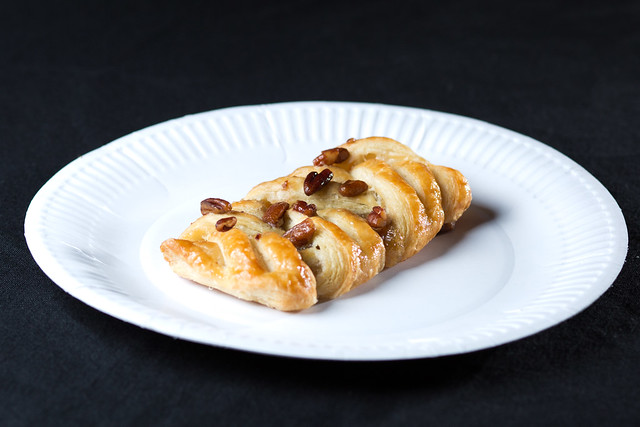- Messages
- 1,689
- Name
- Michael A. Sewell
- Edit My Images
- No

Food photography depends very much on good light, and yet the textures and shapes can respond extremely well to quite a simple lighting setup.
Whether I'm shooting on location in a restaurant, or in a studio for Getty Images, my lighting setup tends to be similar.
I'm particularly careful to ensure the food glistens to add allure. I don't mean “glisten”, as in added oil. I mean the specular highlights caused by the light. As light travels in straight lines, then placing the light on the far side of the food, in line with the camera, will potentiate the reflective properties of anything glossy. Glossy can be fluid, oils or just the wet nature of the food itself. It can be seen above, along the ketchup and mustard, the side of the bratwurst, and also along the edges of the onion rings.
If you bear in mind the angle of incidence, you can pretty much place the light, and know where the highlights will appear. That said, as the light is basically being directed towards the camera lens, a grid is essential to negate flare, and therefore reduce the possibility of loss of contrast.
I tend to use the Lencarta Atom 360 or 180 for food photography, as the lights tend to be quite close, to the point that sometimes, the 360s are operating at minimum output. Atom 180s are probably the better choice, allowing a little more manoeuvrability in the power output.
In the above image, the rim light was placed frame right, beyond the table. I usually have the rimlight head slightly above the camera height, so as to ensure the light source doesn't appear in the frame. I fire it through a dedicated beauty dish with a grid fitted. This provides a larger pool of light than a gridded standard reflector but maintains quite tight control over the light. For the above image, I used an Atom 360, firing through the mentioned Beauty Dish and grid at a power output of 1/128th
The main, or key light, is another Atom 360 (or AD180), usually firing through a 80x80 folding softbox. Normally, this is placed as close to the table as possible, almost directly overhead. Here, I wanted it slightly further back. In fact, it was pretty much in line with me. Again, the output was set to 1/128th power output.
To be honest, this setup varies little, other than the position of the lights, which depends on the food being photographed, as I'm looking to get the best from the specular highlights.
Olympus E-M1 1/125th sec ISO400 12-40mm @40mm f8

This is a pull back, showing the setup. Olympus E-M1 1/125th sec ISO400 12-40mm @40mm f8
Photographing food for a restaurant or bistro, tends to be quite different to photographing food for Gettys. With a restaurant, your aim is to include the ambience of the restaurant, which can be attained by including out of focus lit areas of the bar, or branded condiments and cutlery etc. Often the plates are particular to that restaurant. We are aiming to create a familiarity within the image for past customers, hoping to stir them to return, as well as new customers, whom we are hoping to tempt into a welcoming environment.
When shooting for a stock library or recipe book, there isn't the familiarity aspect to draw on. No brand, house crockery or cutlery etc. We have to build the whole set from scratch, sometimes to a brief, sometimes not.
In this case, it starts with a table, then the food support. As it's a hotdog, a brown paper “wrapper” seemed best suited. We also sort the supporting cast of props that are suited to the scene.
The hotdog was part of a series of images along a street food theme, such as burgers and steak sandwiches etc.

The above is again the same two light setup, but with the accent light switched to left of frame.
Olympus E-M1 1/125th sec ISO400 12-40mm @40mm f8

If there is the potential for steam from the dish, I have a third Atom 360 (or 180) set to fire across the dish at 90 degrees to the camera, and at the same height as the dish. Again, I make use of a dedicated Beauty Dish and grid, and once again, it tends to be at the lowest possible power output, due to the small distances from the light source to the food.
Here, I needed a longer exposure and an increased sensitivity to ensure the candle registered.
E-M1 1/30th sec ISO800 12-40mm @29mm f5.6
All above images are Olympus E-M1 captured, the two below are a few months earlier, and Nikon captured.

ok, it's not a real table, It's a painted interior door we found.
Same two light setup, although the lights were positioned a little further away than usual, due to the required broader scene.
This was shot a week or so before the E-M1 arrived.
I've found the Olympus to be particularly suited for food photography for a number of reasons, not least the depth of field and close focus ability of the 12-40mm f2.8. The stabilisation means no tripod is required, even when shooting at 1/30th sec and slower, allowing the capture of candle light etc.
Due to the limit of 5 images per message, the final image is in the next post.




 Pecan Pie
Pecan Pie